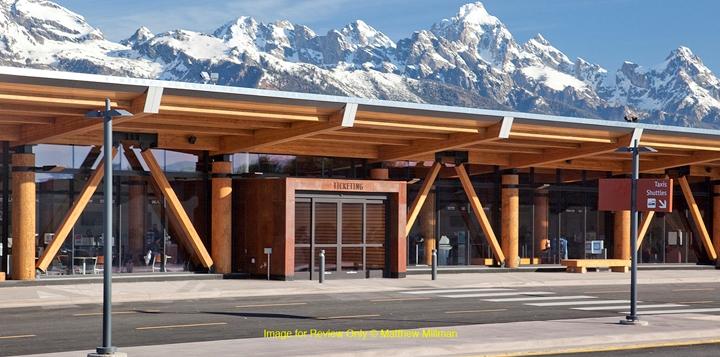Long, low and archetypically Western, the new addition to the Jackson Airport in Wyoming is the product of a collaborative effort between Gensler and Carney Logan Burke Architects.
Though John Carney’s firm partnered with another in the design competition for the project and Gensler was ultimately selected, airport officials decided to hook the two up. It turns out Carney and Gensler’s Phil McCurdy had worked together 25 years back. The first thing Carney did was take Phil out to his firm’s work at the nearby Laurence S. Rockefeller Preserve.
“Gensler was the lead architect and we were consulting,” says Carney. “And those guys really got it. They showed up for the competition with a parti that was just beautiful. They said: ‘We’re not competing with the landscape.’”
The Grand Tetons linger in the background behind the airport, the only one in the nation completely surrounded by a national park.
The architects designed a very long bar that runs north and south for the addition, working with an existing height restriction of 17 feet. As the ground slopes off to the south, the 54-foot long building deepens. An overhanging canopy now covers a wall of transparent glass in front of the old airport, completely burying it
“It looks and feels Western, but not kitsch,” Carney says. “It’s a 21st – century transportation hub that needed to be of its time.”
Jackson’s airport is the busiest in Wyoming. Where regional jets carrying 35 people used to come in, 737’s and A319’s now unload 180 people at a time. And they all want to leave simultaneously, during a morning window from 6:30 to 8:30 AM.
“There are about a thousand people who want to fly out for connections elsewhere, all at once,” he says.
The new ticketing hall uses high-tech kiosks and streamlined security lines to move people along quickly. The 55,000 square foot facility employs steel, native stone, polished concrete floors and weathered Wyoming fence wood for an elegant effect. A set of clerestory windows allows a peek out to the Tetons in the distance.
“It’s a work inspired by place,” he says. “We’re building in God’s country, and within fragile ecosystems.”
And they’re aiming for LEED Silver.
For more, go here.

